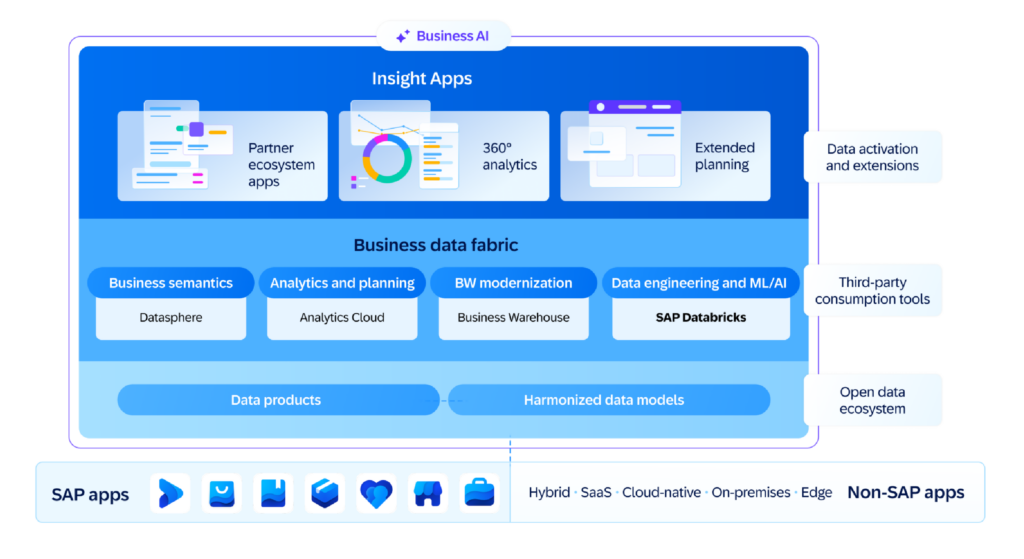Modernizing Data Strategy with SAP Business Data Cloud: What Enterprises Need to Know
Two years back, SAP held an event called “Data Unleashed” and introduced Datasphere, a new version of their Data Warehouse Cloud. Back then, it felt like a tool still finding its feet, with only a few added features. Most SAP BW users were happy with their current setup and didn’t find any need to change to upgrade, while the rest felt it didn’t match up to leaders like Databricks or Snowflake.
Things have changed. SAP put in a lot of effort and came up with the much-improved Datasphere, making it stronger and naming it the future replacement for SAP BW. They’ve focused on what businesses want – easy ties to S/4HANA and SAP Analytics Cloud – plus ways for regular users to join in. Moreover, SAP teaming up with major names like Databricks shows that the company is opening up for partnerships and delivering partner solutions, enabling them to fix weak spots and keep up with trends that businesses care about.
Databricks has long been ahead with clever, low-cost data systems and top-notch data and analytics and AI. SAP has been trying to catch up, and their quiet teaming up with Databricks over the last two years has been building to something interesting
Modernizing Data Strategy with SAP Business Data Cloud (BDC)
Recently, SAP announced SAP Business Data Cloud (BDC), a unified platform (in partnership with Databricks) for enterprise data, combining data management, analytics, and AI capabilities. SAP BDC is designed to streamline how organizations access, analyze, and act on data, playing a strategic role in modern data architectures by enabling intelligent decision-making across both SAP and non-SAP environments.
Consider an organization managing its operations with data spread across multiple systems—one handling sales, another overseeing human resources, and a third for tracking financials. Each system contains critical information, yet they operate in isolation, making it challenging to consolidate this data for a unified view of the business. SAP BDC serves as a centralized platform that gathers all this information into a single location, simplifying the process of understanding and leveraging it effectively. In clear terms, SAP BDC is a cloud-based solution that supports enterprises by:
- Unifying diverse data sources: It integrates data from SAP applications (such as S/4HANA for financial operations) and external systems (like third-party tools) into one cohesive platform.
- Providing clarity on business trends: It organizes the data to help identify patterns, generate reports, or enhance planning efforts; for instance, pinpointing why sales have declined in a specific area.
- Leveraging AI for better outcomes: The platform employs AI to analyze data and recommend actions, such as forecasting future demand or automating routine processes.
- Enabling swift decision-making: With all data centralized, businesses can make quicker, more informed choices, like adjusting stock levels based on live sales figures.
For instance, a retail company might use SAP Business Data Cloud to merge data from its physical stores, eCommerce platform, and customer reviews to determine which items to prioritize in inventory, all with minimal effort. This solution is designed to streamline operations, reduce complexity, and empower organizations to act on insights without requiring extensive IT support.
Is SAP Business Data Cloud a Solution or a Framework?
Based on the history of SAP, users may be wondering: Is it again rebranding and bundling several tools into a package, or is it really one cohesive solution?
SAP Business Data Cloud is a Software-as-a-Service (SaaS) solution built on the SAP Business Technology Platform (BTP). It combines components like SAP Datasphere, SAP HANA Cloud, SAP Analytics Cloud, and integrations like Databricks into a unified, cloud-native offering. Its goal is to simplify data management, analytics, and AI across enterprise systems. It follows the principles of the Business Data Fabric—an architectural concept that ensures unified, semantically rich, and governed access to data across hybrid and multi-cloud environments. So, while SAP Business Data Cloud is a solution, it’s designed to enable and operationalize this architectural framework.
Motivation Behind SAP Business Data Cloud
From SAP’s perspective, tools like Datasphere and SAP Analytics Cloud were already in place, but businesses needed a better way to pull together and study data from various sources without the struggle of managing separate systems. The goal was clear: deliver quicker, more dependable insights to support smarter business choices. SAP BDC met that need.
First, it focuses on simplicity. Rather than piecing together data from different platforms by hand, the platform automates the process through what’s known as “Data Products.” This method saves time and reduces errors, making data work smoother for companies. Next, it offers out-of-the-box insights. With pre-built “Insight Apps,” users can jump straight into viewing and exploring their data without complex setup. It’s a practical design that gets businesses their answers faster.
Finally, the platform emphasizes openness. It pulls in data from both SAP and non-SAP systems, giving a fuller, clearer view of an organization’s information. This eliminates the frustration of working with isolated tools, a challenge we often see when guiding companies through data integration efforts. The result is a more unified approach that aligns with what forward-thinking businesses need to thrive.
A Deep Dive into SAP Business Data Cloud: Integrating, Governing, and Activating Enterprise Data
SAP BDC simplifies enterprise data management by connecting, organizing, and using data effectively. Its business data fabric framework brings together information from SAP and external sources, such as market trends or supplier updates, to support strong analytics, AI insights, and seamless data sharing for business applications. Below is a clear, concise overview:
- Integrating Diverse Data Sources:
BDC combines SAP data, like sales or inventory records, with outside information, such as news or logistics reports, into one clear system. For example, a retailer could link a sales drop to a competitor’s promotion, making it easier to understand trends and analyze data thoroughly.
- Governing with Clarity and Control:
BDC ensures data is accurate and secure by setting strict access rules and tracking details, like who can view financial reports. This keeps information reliable and compliant, so businesses can trust it for decisions and share it safely across tools.
- Activating Insights with AI and Speed:
BDC turns data into action with AI and analytics that highlight trends and suggest steps. A manager noticing low stock could quickly identify a supplier issue and adjust orders in the same system, driving faster, better outcomes like cost savings or improved service.
 Credit: SAP – Business Data Cloud
Credit: SAP – Business Data Cloud
Overall, BDC’s data fabric creates a smooth process for collecting, managing, and acting on data, helping businesses make informed decisions quickly and achieve real results. This is supported by the following components of SAP Business Data Cloud:
- Foundation (HANA Cloud): SAP Business Data Cloud runs on SAP BTP, which provides foundational services like scalability, security, and connectivity. It uses SAP HANA Cloud as its underlying database for high-speed, in-memory data processing.
- SAP Datasphere: At the core, SAP Datasphere manages data integration, modeling, and governance. It creates a unified semantic layer: a business-friendly view of data that abstracts technical complexity, allowing users to work with terms like “revenue” instead of raw database tables.
- SAP Analytics Cloud: This component delivers visualization and planning tools, enabling users to build dashboards, run ad-hoc analyses, data exploration, and what-if analytics, and perform financial or operational planning. It supports out-of-the-box reporting through prebuilt “Insight Apps.”
- SAP Databricks Integration: For advanced analytics, SAP BDC integrates with Databricks, allowing data professionals to build AI models, machine learning workflows, and generative AI applications using business data from SAP and non-SAP platforms.
How It Fits into the “Insights to Action” Framework
The “Insights to Action” framework is fundamentally about bridging the gap between identifying useful patterns or issues in data (insights) and making swift, informed decisions based on those findings (action). It’s a process that emphasizes not just collecting and analyzing data but ensuring that the analysis directly feeds into tangible business outcomes. Turning data insights into quick, meaningful business choices takes more than just numbers and calls for a setup, where spotting a problem and solving it go hand in hand. SAP BDC delivers this by creating a smooth path from discovery to action.
What makes this particularly powerful is how SAP BDC builds on the legacy of S/4HANA Embedded Analytics, a system known for embedding real-time data analysis into business processes. While S/4HANA focused heavily on SAP’s internal ecosystem, Business Data Cloud takes it further by integrating external data sources—think third-party supplier databases, market trends, or even weather forecasts that might affect logistics. This broader scope means decisions aren’t just based on what’s happening within a company, but on a fuller picture of the operational landscape.
Consider a supply chain manager who spots a possible inventory shortage. With this platform, they can dig into the data, maybe uncovering a holdup from an important supplier, or an upcoming weather storm, and then take steps, like placing a purchase order ahead of time or from another supplier, all in one place.
Final Reflections: Strategic Considerations for Adopting SAP Business Data Cloud
At its essence, SAP Business Data Cloud provides enterprises with a centralized platform to integrate, examine, and leverage their data, harnessing AI and preconfigured tools to accelerate decision-making processes. From a technical perspective, it operates as a SaaS solution on BTP, consolidating data from both SAP and non-SAP sources into a unified semantic framework, enabling sophisticated analytics, AI-driven capabilities, and the delivery of actionable outcomes through fully managed applications.
While the platform offers substantial advantages for organizations deeply embedded in the SAP ecosystem, its enduring effectiveness hinges on its ability to navigate the delicate balance between interoperability, cost efficiency, and adaptability within an increasingly competitive data management landscape. Enterprises aiming to refine their data strategies will find SAP Business Data Cloud to be a formidable tool; however, a meticulous assessment of its alignment with existing infrastructures and future objectives is imperative to ensure a seamless and value-driven implementation.
To chat more about modernizing your data strategy with SAP, reach out to one of our SAP experts today.
Subscribe to Clarkston's Insights



